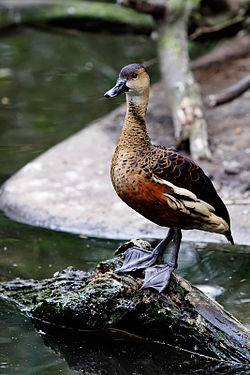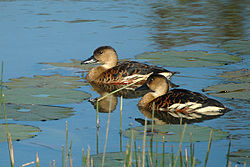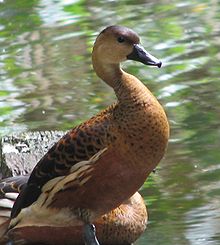- Wandering Whistling Duck
-
Wandering Whistling Duck 
Conservation status Scientific classification Kingdom: Animalia Phylum: Chordata Class: Aves Order: Anseriformes Family: Anatidae Subfamily: Dendrocygninae Genus: Dendrocygna Species: D. arcuata Binomial name Dendrocygna arcuata
Horsfield, 1824Subspecies - D. a. arcuata (Indonesian Wandering Whistling Duck) (Horsfield, 1824)
- D. a. australis (Australian Wandering Whistling Duck) (Reichenbach, 1850)
- D. a. pygmaea (New Britain Wandering Whistling Duck) (Mayr, 1945)
The Wandering Whistling Duck (Dendrocygna arcuata) is a species of whistling duck. They inhabit tropical and subtropical Australia, the Philippines, Indonesia, Papua New Guinea and the Pacific Islands [1]. There are three subspecies associated with this bird. D. arcuata arcuata (Indonesian Wandering Whistling Duck), D. arcuata australis (Australian Wandering Whistling Duck), and D. arcuata pygmaea (New Britain Wandering Whistling Duck).
Contents
Description
Formerly named Tree Ducks, the Wandering Whistling Duck have their new name because of their loud whistling calls and the whistling noise their wings make during flight.
They have long necks and legs and look like a cross between a goose and a duck. They have a strong head and neck with a darker crown and hindneck. The breast contains black spotting and the feathers are mostly dark brown.
They range in size from 54–60 cm in height and weigh on average 750 grams. They mainly feed on grasses, waterlillies, water plants and occasionally insects and aquatic vertebrae.
Habitat
The Wandering Whistling Duck lives in deep lagoons, flooded grasslands or dams. They enjoy the water and rarely leave the shore. They can swim and dive with ease.
Breeding
Breeding occurs during the tropical wet season usually between December and May. During this time six to fifteen eggs are laid in a nest not far from water and usually in high grass or a sheltered area.
Yandina, SE Queensland
References
- BirdLife International (2004). Dendrocygna arcuata. 2006. IUCN Red List of Threatened Species. IUCN 2006. www.iucnredlist.org. Retrieved on 11 May 2006. Database entry includes justification for why this species is of least concern
- Field guide to the birds of Australia Graham Pizzey and Frank Knight, Angus & Robertson 1997, 3rd edition 2000. ISBN 0-207-19714-8
- ^ (Pizzey. G, Knight. F 1997 p. 26)
External links
Categories:- IUCN Red List least concern species
- Dendrocygninae
- Birds of Southeast Asia
- Birds of Indonesia
- Birds of Western Australia
- Birds of Australia
- Birds of Fiji
- Birds of New Caledonia
- Birds of Papua New Guinea
- Birds of the Philippines
Wikimedia Foundation. 2010.



